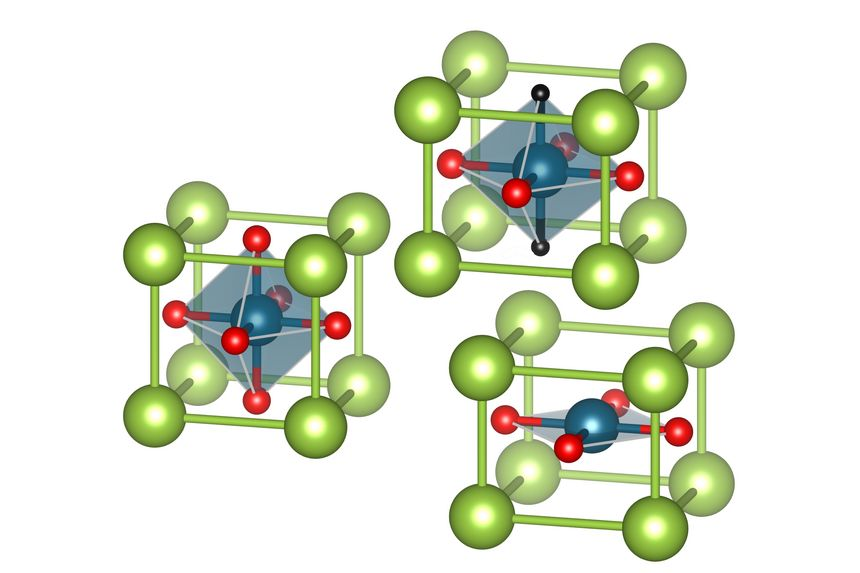Apr 28 2020
A new age of high-temperature superconductivity—the nickel age—was declared last summer. Researchers found that a unique class of materials called nickelates includes potential superconductors that can conduct electric current with zero resistance, even at high temperatures.
 When hydrogen is incorporated into the nickelate structure, it is not a superconductor. Image Credit: TU Wien.
When hydrogen is incorporated into the nickelate structure, it is not a superconductor. Image Credit: TU Wien.
But soon, it became evident that these initially spectacular outcomes from Stanford could not be replicated by other research teams. At present, researchers at TU Wien (Vienna) have discovered the reason behind this: the material structure of certain nickelates includes additional hydrogen atoms. This totally alters the material’s electrical behavior. It is essential to consider this effect while producing new superconductors.
The Search for High-Temperature Superconductors
Certain materials exhibit superconductivity only near absolute zero temperature, making them inappropriate for technical applications. Thus, for several decades, researchers have been searching for materials that exhibit superconductivity even at higher temperatures. “High-temperature superconductors” were discovered in the 1980s.
However, the so-called “high temperatures” in this context are still very cold: it is essential to strongly cool even high-temperature superconductors to unravel their superconducting properties. Thus, there is a continuous quest for new superconductors at much higher temperatures.
For a long time, special attention was paid to so-called cuprates, i.e. compounds containing copper. This is why we also speak of the copper age. With these cuprates, some important progress was made, even though there are still many open questions in the theory of high-temperature superconductivity today.
Karsten Held, Professor, Institute of Solid State Physics, TU Wien
Other possibilities are also being considered at present. Already, there was a so-called “iron age” based on iron-containing superconductors. In summer 2019, the researchers led by Harold Y. Hwang’s research group from Stanford was successful in demonstrating high-temperature superconductivity in nickelates.
“Based on our calculations, we already proposed nickelates as superconductors 10 years ago, but they were somewhat different from the ones that have now been discovered. They are related to cuprates, but contain nickel instead of copper atoms,” added Karsten Held.
The Trouble with Hydrogen
However, following some initial hype, in recent months, it has been evident that nickelate superconductors are highly challenging to synthesize than considered earlier. As per reports from several other research teams, their nickelates did not exhibit superconductivity. At present, researchers from TU Wien have clarified this evident contradiction.
“We analysed the nickelates with the help of supercomputers and found that they are extremely receptive to hydrogen into the material,” stated Liang Si from TU Wien. It is possible to add hydrogen atoms during the production of some nickelates, thereby completely modifying the electronic properties of the material.
However, this does not happen with all nickelates. Our calculations show that for most of them, it is energetically more favourable to incorporate hydrogen, but not for the nickelates from Stanford. Even small changes in the synthesis conditions can make a difference.
Liang Si, Researcher, from TU Wien
On April 24th, 2020, the team led by Ariando Ariando from NUS Singapore reported that it successfully synthesized superconducting nickelates. They allowed the hydrogen released during the synthesis to escape instantly.
Calculating the Critical Temperature with Supercomputers
Researchers at TU Wien are developing new computer calculation methods and using them to perceive and estimate the properties of nickelates.
Since a large number of quantum-physical particles always play a role here at the same time, the calculations are extremely complex. But by combining different methods, we are now even able to estimate the critical temperature up to which the various materials are superconducting. Such reliable calculations have not been possible before.
Liang Si, Researcher, from TU Wien
Specifically, the TU Wien researchers could calculate the permitted strontium concentration range for which the nickelates exhibit superconductivity—at present, this prediction has been confirmed experimentally.
“High-temperature superconductivity is an extremely complex and difficult field of research. The new nickelate superconductors, together with our theoretical understanding and the predictive power of computer calculations, open up a whole new perspective on the great dream of solid state physics: a superconductor at ambient temperature that hence works without any cooling,” concluded Karsten Held.
Reference:
Si, L., et al. (2020) Topotactic Hydrogen in Nickelate Superconductors and Akin Infinite-Layer Oxides ABO2. Physical Review Letters. doi.org/10.1103/PhysRevLett.124.166402.